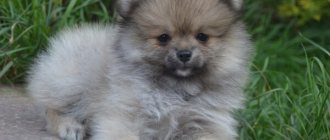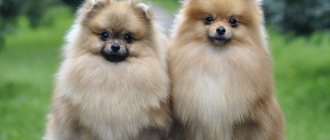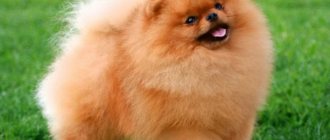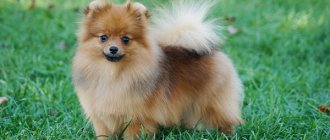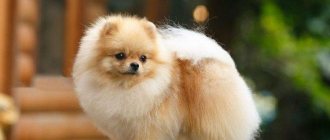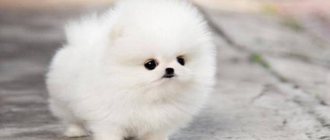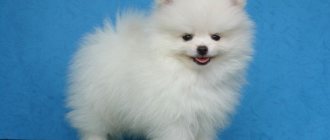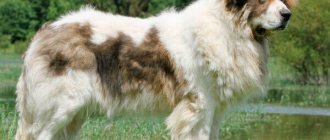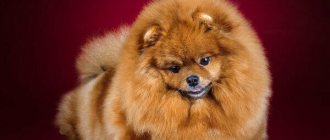5 / 5 ( 2 voices)
The Pomeranian is the smallest and most energetic member of the Spitz-type dog breed. Representatives of the breed are easy to train, affectionate and devoted to their owners, courageous, very sensitive, but sometimes they can annoy with uncontrollable barking for any reason. Decorative miniature dogs are loved by many; they are wonderful companions and loving pets. The Pomeranian is one of the twenty most popular dog breeds in the world.
The Pomeranian is one of our favorite dog breeds.
Origin story and what it looks like in the photo
The ancestors of the dwarf Pomeranian are the common German Spitz. In the mid-18th century, these were dogs that were approximately knee-high. And they also weighed a lot - from 14 to 23 kg.
People of that era were happy with just such large Spitz dogs, because they were not only reliable and devoted companions, but also guards.
The fashion for small dogs, which could be kept in boudoirs and carried in arms, began later - already in the 19th century. It was then that Queen Victoria personally began breeding a smaller copy of the German Spitz.
The ancestor of the Pomeranian Spitz, including the dwarf variety, was a dog named Marco, whose weight was 5.4 kg.
As a result of properly carried out breeding work, the size of Spitz dogs was almost halved by the end of Victoria’s reign.
True dwarf Pomeranians were bred in the mid-20th century..
It is assumed that the Spitz, which could well be called a pocket dog, originated in Japan, and that this was due to the fact that in Japanese cities apartments are very small.
So breeders have developed a new variety of oranges, which are particularly small in size and do not require a large living space.
Pet care
Like any dog, the white fox Spitz needs care. His appearance and health depend on this.
Diet
A good choice would be ready-made dry food - it contains all the necessary vitamins and microelements. The main thing is to buy quality food. It contains meat, not soy. It is not cheap, but the Spitz eats very little - 3-4 kg of food is enough for a month.
What to feed a Spitz fox
In addition, it is advisable to purchase special food for miniature dogs - large granules may be too much for a Spitz with its weak jaws.
Grooming
In order for wool to look chic, it needs to be properly cared for. She needs to be brushed twice a week, and when the Spitz sheds, the procedure needs to be done daily.
Note! It is best to use a plastic comb, and ideally a bone comb. Metal damages the fur.
Don't forget about the bath. You need to bathe your Spitz every two months using a special shampoo.
Walking and physical activity
It is advisable to walk in the morning and evening. Morning exercise is at least 10-15 minutes, and evening exercise is from half an hour. During the walk, the dog should run around a lot. True, long-term exercise is not suitable for him - let him run a little after the ball, and then rest, lying next to his beloved owner.
Walks are very important for your pet
In the summer heat, it is advisable to reduce your load and always have a bottle of water with you.
Separate breed or genetic marriage? What is the difference from the mini?
Dwarf Pomeranians are not allowed for exhibitions or breeding. And as adorable as they are, they should be considered a breed defect.
Dwarf Pomeranians are even smaller than the mini variety of this breed, weighing on average 1.7-1.9 kg .
Spitz mixes
The last Pomeranian species is the most interesting because we will talk about mixes.
Designer breeds, as people call it when you cross two types of dogs from different breeds, are a controversial topic. Reputable breeders do not accept them because these mixed dogs do not strengthen the pedigree or improve the breed.
Mixed Pomeranians have traits from both breeds and can have a rather unique appearance. But this is precisely what makes them so popular and desirable.
Believe it or not, there are over 30 Pomeranian blends. Some of the most popular:
- Pomchi - Pomeranian and Chihuahua
- Bishonaran - Pomeranian and Bichon Frize
- Dameran Spitz and Dachshund
- Pomsky - Pomeranian Spitz and Husky
- Pomapoo - Pomeranian Spitz and Poodle
- Shiransky - Spitz and Shih Tzu
- Maltipom - Pomeranian and Maltese.
So, if you're wondering why your Pomeranian looks so much like one of these breeds, it might actually be a mixed dog. Unfortunately, you cannot tell how purebred your Pomeranian is without a DNA test.
Dwarf Pomeranian Spitz
The Dwarf Pomeranian is a small, active and energetic dog, distinguished by intelligence, intelligence and playfulness.:
- Their body is square.
- The head is moderately convex, with a well-defined transition to a rather short, but not wide muzzle.
- The ears are small, erect, triangular in shape.
- The eyes are almond-shaped, dark brown. The look is lively, smart and friendly.
- The nose is black; in brown Spitz dogs it is brown.
- The neck is not too long, with a smooth transition to the withers. The back is flat, straight and rather short. The chest is of sufficient depth and volume. The belly is moderately adjusted.
- The forelimbs are level, straight and parallel. The hindquarters are moderately muscular and are pulled back somewhat when standing.
- The tail is in a ring or simply carried over the back in the form of a plume.
The wool is two-layer, consisting of a fairly strong, but at the same time elastic, outer coat and a very soft undercoat, which looks and feels like cotton wool.
The Dwarf Pomeranian should look compact, but not squat..
Normal/Fox Spitz
The American Kennel Club breeding standard is pretty clear when it comes to Pomeranians and what they should look like. Fox-shaped or "normal" Pomeranians meet this standard.
© shutterstock
According to this breeding standard, Pomeranians should have a round skull, small erect ears, deep almond-shaped eyes, and a heavily feathered tail that lies on the back. The body should be square with a height to length ratio of 1:1.
The coat should consist of two layers - a short, dense undercoat and long guard hair. While all coat colors, patterns and variations are acceptable, the eyes should be dark with black edges, which is usually the case with solid-colored fluffies.
The standard specifies that the Pomeranian's muzzle length should be between 1/3 and 2/3 the length of the skull, and the facial expression should be alert and intelligent. This is what gives the Pomeranian's face a foxy appearance.
Pet character
Dwarf Pomeranians are distinguished by their cheerful disposition, playfulness and devotion to their owners . They cannot be called pampered or fragile: they are active and mobile pets who love to run and play.
They are quite smart and well trained. However, the Pomeranian does not always agree to carry out the owner’s commands, since with improper upbringing the dog grows up selfish, capricious and stubborn.
It is also very important that the pet is socialized, otherwise problems may arise later due to its aggressiveness towards other animals.
Despite the fact that the Dwarf Pomeranian Spitz is good with children, it is not one of the breeds whose representatives are kind to children's pranks.
These dogs hate being teased or made uncomfortable and, without hesitation, can snap at their offender or even bite.
Expert opinion
Kozhevin Semyon Kirillovich
Expert dog handler.
“A dwarf Pomeranian, which is the smallest in size of all Pomeranians. This variety is not officially recognized, but these dogs are very popular as pets. In addition to their charming appearance and thick, fluffy coat, they also have such positive qualities as a wonderful character, mobility and energy. Such pets are well trained, but only if from an early age the owner spared no time and effort on their upbringing and socialization.”
Advantages and disadvantages
Among the most obvious positive aspects are:
- cheerfulness;
- intelligence;
- security deposits;
- loyalty and friendliness;
- love for children.
The dog has a very loud and ringing bark
. Disadvantages include:
- loud and restless barking;
- cockiness, attempts to dominate;
- manipulation;
- suspicious of strangers.
Advantages and disadvantages
pros:
- Sweet and charming.
- They do not need a large living space.
- Energetic, agile and quite resilient.
- They are friendly and loyal to the owners.
- They love children, but you need to remember that only children over ten years old can play and communicate with such a pet.
- They willingly use a diaper or tray if they are accustomed to it.
- You can take them with you on any trip.
Minuses:
- If raised incorrectly, they can grow up stubborn, capricious and disobedient.
- If you cause them discomfort, they may snap or bite.
- They are not always friendly towards other animals.
- They are characterized by increased emotionality.
- If you don't teach them to be quiet in your house or apartment, they will bark constantly.
- Needs careful handling.
- They shed heavily.
- Dwarf Pomeranians with short snouts are prone to heart disease.
- Not allowed for exhibitions and breeding.
One of the main disadvantages is that you can buy a regular-sized dog under the guise of a dwarf orange.
Breed characteristics and character traits
Pomeranians make excellent companion dogs, no matter if they are foxes, teddy bears, or toy Pomeranians. They become very attached to their owners. Many Spitz dogs adapt very easily to their owners' habits.
- Shall we play?..
The owner is a homebody, loves to lie on the sofa watching TV - the pet will also lead a measured, lazy lifestyle. With an energetic owner, pets seem to be charged with energy from the owner; they can play for a long time, filling the apartment with ringing barks.
Despite its “toy” appearance, the Pomeranian is quite capable of displaying the qualities of a watchman, a “caller,” and, if necessary, the pet will rush at the alleged offender.
As for security qualities, the Spitz has them in full. The dog may attack a suspicious stranger, and in any case, barking will notify the whole house of the presence of an intruder. Spitz are distrustful of strangers. Pomeranians are not afraid of cold.
A family with small children (under 5 years old) should not take a Spitz, or even most dog breeds. It is difficult to explain to a child at this age that a dog is not a toy, it cannot be squeezed, squeezed, or treated like a toy. Spitz will play with pleasure with older children.
But the Spitz may try to “build” other pets, to be the leader in this small pack. However, if you take a Spitz and other animals into your home at the same time, they will live peacefully.
Types of dogs
There are three types of dwarf Pomeranians, differing from each other in the structure of the head, muzzle, ears and coat length.
"Bearish"
Bear-type dwarf Pomeranians look like teddy bears, which is often emphasized by their haircut. Their head is round and wide, and their muzzle is slightly upturned and very short.
Some "bear" type Spitz have a muzzle length that does not exceed a centimeter . The nose is large, the eyes are quite close-set, very dark and expressive.
Long and thick hair on the animal’s cheekbones creates the illusion that the dog’s cheeks are round and plump.
Currently, it is the dwarf oranges of the “bear” type that are especially popular.
This is not always to the benefit of the breed, especially when you consider that in the pursuit of a more endearing appearance of such dogs, their health is often sacrificed for the sake of fashion.
"Fox"
Fox-type Dwarf Pomeranians are similar to the classic German Spitz. With the shape of their head and rather long, narrow muzzle, they resemble small fluffy foxes.
Like other Pomeranians, they have a square body, but their paws and tail are longer than those of other representatives of the breed . The fur of “fox cubs” is average in length and fluffiness.
"Toy"
Spitz "toys" belong to the intermediate type. Their muzzles are longer than those of bear cubs, but shorter than those of foxes.
They got their name due to the fact that their eyes are quite widely spaced and set higher than those of “bear cubs”, which gives them a special, “doll-like” expression of the muzzle.
Questions and answers
What is the difference between a toy-type Pomeranian and a fox?
There are several differences between the Toy Pomeranian and the Fox Spitz. The first is size: chanterelles are larger. The second difference is the shape of the muzzle. In puppet representatives of the breed it is flat, while in foxes it is elongated and pointed at the end. And the third difference is the coat color. Fox Pomeranians come in a variety of colors, while toy Pomeranians are always white.
How much does a Spitz toy cost?
The price for a Pomeranian doll ranges from 40 to 90 thousand rubles. It depends on the class to which the puppy belongs, on its pedigree and external characteristics.
Basic colors
- White. The white dwarf orange should have a snow-white color. No extraneous shades in the form of darkening or yellowing of the coat are allowed.
- Black. A black Spitz should be pure black, with no brown, gray or reddish tints.
- Black and Tan . Jet-black base coat color, complemented by fawn or red markings located above the eyes, on the muzzle, ears, neck, chest, limbs and on the inside of the tail.
- Brown . Can be any of the brownish shades.
- Soboliny . The outer coat is zonally gray in color, and the undercoat is grayish, orange or cream.
- Ginger . It comes in different brightness and intensity: from golden to bright reddish-red. Also, dogs of orange color often have lightening of the fur on the inside of the paws, on the tail and on the neck.
- Cream . It may appear almost red or be difficult to distinguish from white.
- Zonal gray . The guard fur is darkened around the eyes, eyebrows, ears and tail. The undercoat is silver-gray. Due to this, an interesting effect of gradation of fur shades is created, making the orange look like a small wolf.
- Two-color . The main color of the coat is white. There are small markings on it in one of the three colors allowed by the standard: black, reddish or brown.
All other color variations, including merle, blue, tri-color and brown and tan, should be considered breeding grounds..
Husky and Spitz mix
The breed was named Pomsky. These dogs have become an exclusive designer find, but today they remain not recognized by the International Canine Federation. The color of the Pomsky usually matches the color of the Husky's coat. The most common shades are:
- grey-white;
- black;
- white;
- ginger;
- brown.
Usually puppies have a kind of mask on their face. Dogs are easy to train and are smart. Unlike classic Spitz dogs, Pomskies calmly tolerate loneliness.
Life expectancy and health
Standard Pomeranians live 12-16 years, and the dwarf representative of this breed also has a chance of living to that age .
But only if the dog belongs to healthy breeds, and the owners take a responsible approach to keeping and feeding the pet.
These dogs may be susceptible to the following ailments::
- Tracheal collapse.
- Hypothyroidism
- Cardiovascular diseases
- Atlantoaccipital subluxation
- Dislocation of the knee or elbow joint
- Obesity
- Cryptorchidism
- Oral and dental diseases
- Cataract
- Entropion of the eyelids
The use of Pomeranian Spitz dogs with signs of dwarfism in breeding has led to the fact that in addition to general breed ailments, they can also suffer from specific diseases.
Such diseases include:
- Hypoglycemia
- Hydrocephalus
- Incomplete fusion of the skull bones
Dwarf oranges of the “bear” type with very short and flat muzzles also have breathing problems and are predisposed to respiratory diseases.
How many years do Spitz bear cubs live?
Pomeranians, like many small dogs, live quite a long time, 12-15 years. But there are long-livers whose age approaches 20 years. At the same time, dogs can maintain their energy and enthusiasm.
In many ways, the long life of a pet depends on the owner. For a long and happy life for your pet you need:
- Regular visits to the veterinarian, necessary vaccinations. The problem with Spitz dogs is baldness (alopecia), which is mainly a cosmetic problem.
- Good care and a balanced diet - with age you need to reduce food portions and replace meat with fish.
- Control the dog's weight, they should not be overfed - like in humans, excess weight can lead to hypertension, stroke, and liver problems.
On a walk…
Care and maintenance
The Dwarf Pomeranian needs to be brushed with a brush and a wide-tooth comb.
Normally this should be done once a week. But when a pet sheds, you will have to brush it at least daily.
You can bathe your dog no more than 2-3 times a year, and then only when necessary..
IMPORTANT!
Nowadays it has become fashionable to trim Spitz dogs, however, you need to take into account that you cannot cut them with a clipper, as you can easily ruin the hair.
It is recommended to examine your pet's ears and eyes daily . If necessary, clean the eyes with special products purchased at a veterinary pharmacy, first applying them to a cotton pad or swab. The ears are cleaned with cotton swabs.
Teeth are cleaned with treats or chew toys, or brushed with a dog toothbrush coated with a small amount of pet toothpaste..
Dwarf Pomeranians' nails should be trimmed approximately 1-2 times a month.
History of the breed
Spitz-type dogs are the oldest group of breeds. Spitz dogs were known back in Ancient Greece. This is evidenced by their images on vases and bas-reliefs found by archaeologists.
Initially, Spitz dogs were considered herding and guard dogs. With their loud ringing bark, these small “bells”, unpretentious in content, warned the owner in time about danger and uninvited guests. In those days they were much heavier and larger than their modern counterparts. Often their weight reached 13 kilograms
The Pomeranian received its name from the name of the area in Germany - Pomerania, where this breed is believed to originate. He is the smallest variety of the German Spitz.
In the 18th century, the Pomeranian became a favorite breed of royalty, not only of women, but also of men. They were 2-3 times larger in size than they are now. They accompanied their owners everywhere. Their popularity even then was due to their good looks and cheerful, perky character.
Thomas Gainsborough "Two Dogs"
In 1870, Spitz came to England. During this period, Queen Victoria occupied the English throne. There is a legend that because of her short stature (height 152 cm), the fashion for everything miniature was widespread at court. And the queen’s favorite dog at that time was the Spitz, Marco, whom she brought from Europe. Breeders made every effort to breed and provide Victoria with the smallest version of the Spitz.
But their goal was not only to reduce the size of the dog, whose initial height at the withers was 35 cm, and weight - 14 - 15 kg. They also worked to make the breed more sophisticated, aristocratic and fluffy. Over time, the Pomeranian Spitz dog acquired the familiar toy sizes that all lovers of this breed subsequently began to emulate. In 1915, the English Club finally recognized the miniature standard. Larger representatives of the breed are no longer allowed at exhibitions.
View of a Pomeranian Spitz at the beginning of the 20th century.
Feeding and diet
In the first two weeks after purchasing a pet, the puppy should be fed in accordance with the breeder's recommendations..
Only after the process of adapting the baby to the new home is completed, it will be possible to transfer him to the feeding option that is most suitable for the owner.
Due to the small size of the dwarf orange, it can be difficult to calculate the correct ratio of foods in its diet.
Therefore, most breeders and owners feed their dogs a ready-made complete super-premium or holistic food.
When feeding naturally, at least a third of the diet should consist of animal protein products: meat or offal. To them you need to add a little porridge, as well as cottage cheese, kefir or natural yogurt.
A dog’s diet cannot do without vegetables, which are fed to the Spitz both raw and cooked.
The number of feedings depends on the age of the pet: at first, while the puppy is small, he is fed 4-5 times, but by the age of one year he is gradually transferred to twice feeding.
How much do puppies cost?
Mini Pomeranians are expensive. Even for breeding without documents they ask for 10-15 thousand rubles.
The price for purebred Miniature Spitz is off the charts. So, pet-class babies who do not participate in exhibitions and breeding will cost at least 30,000 rubles. Breed-class cuties cost from 50 thousand in rubles. And for future champions they ask for 80-100 thousand rubles and more.
Nurseries
You can buy a Pomeranian Spitz puppy, see photos of litters and parents, and get acquainted with the pedigrees and titles of the producers in the following nurseries in Moscow:
- https://minipes.ru - “Minipes”;
- https://spitz-kennel.com – “Heaven Heart”;
- https://spitzflying.ru - “Flying Spitz”.
In St. Petersburg, the following nurseries are engaged in professional Spitz breeding:
- https://bestilrean.spb.ru – “Best Ilrean”;
- https://www.tswergspitz.rf - “From the cloud over the Neva.”
All of these nurseries are registered with the RKF and the National Breed Club, comply with the rules of these organizations, and breed Miniature Spitz dogs that meet the standard.
The Pomeranian Spitz is a popular decorative dog. However, the demand for it is not good for the breed: unscrupulous breeders often dump sick puppies and adjust the exterior of the Miniature Spitz to the demands of fashion and the desires of buyers. To get a healthy, purebred dog, you will have to memorize the standard and choose a kennel that works according to the rules of the Russian Canine Federation.
How to choose?
You need to purchase such a pet with documents, from a nursery or from a breeder. At the same time, it is very important that the puppy is healthy himself and belongs to healthy lines.
It would also be useful to agree on an examination of the selected baby in the clinic before purchasing . As a rule, conscientious breeders have nothing against this, since they are confident in the health and quality of their dogs.
When choosing a baby in the litter, you also need to pay attention to how active and friendly he is.
NOTE!
A good dwarf orange puppy is quite active and playful, he is not afraid of people and willingly approaches them to get to know them.
At the time of sale, children must have received the age-appropriate vaccinations and undergo quarantine.
When buying white, black, and brown puppies, you need to keep in mind that their color should be as uniform as possible.
As for orange oranges, at an early age they often have a grayish coating, which will disappear over time.
Puberty and mating
For this breed of dog, a special breeding regulation has been developed, which stipulates the permitted age for mating - from 12 to 15 months.
You can start mating at one year of age
Note! According to veterinarians, puberty does not occur in dogs of this breed from the first heat. It is best to bring pets only on their third heat.
You can determine actual sexual maturity yourself:
- outwardly it is an adult animal;
- height and weight correspond to the breed standard;
- Bitches have a regular cycle.
Before breeding, make sure both pets are completely healthy. It would be ideal to conduct a veterinary examination of both the male and the female before the procedure.
When choosing a dog for breeding, consider:
- pedigree;
- presence of birth diseases;
- relationship between a bitch and a dog;
- presence of deviations from standards;
- quality of descendants, if any.
Walking with a pet
Due to the ability to accustom a Pomeranian to a litter box, the need for walks in this breed is lower than in large dogs. But do not forget that Spitz are very active dogs. To direct their energy in the right direction, you need to walk your pet for at least 1 hour every day.
Note! Innate curiosity haunts the dogs; literally everything in the area arouses the interest of the pocket Spitz. While walking, the cubs love to run and play active games. Balls, sticks, frisbees and other devices will delight your pet. Plus, walking is a great time for training.
Pomeranians easily tolerate transportation in a special carrier or in the arms of the owner. Therefore, you can go for a walk to new places without unnecessary worries.
Coat and color
The coat is thick, long and straight. The hard outer hairs of the coat are located perpendicular to the dog's body, since it has a very thick undercoat. The Spitz dog has an unusually beautiful and elegant collar, as well as fluffy “pants” on its hind legs. The tail is curled into a ring and covered with thick hair.
A dog can have unusually beautiful and varied shades of fur. These can be bright red, orange, brown, blue, white, black, cream and other colors. There may be two-tone color options. The puppies will acquire their final tone by the age of six months, after the first molt.
Training
Despite the high intelligence, training a Pomeranian has its own difficulties. This is due to the dog's independence. Raising a puppy should begin from the moment it arrives in the house. It is necessary to show persistence, consistency, and firmness in teaching your child.
Class time should be short, the lessons themselves should be interesting and rich. Good results should be rewarded with treats. When training, it is the owner who must decide how much the pet will exercise. Disobedience and stubbornness must be stopped gently but decisively.
Price
Experts warn that conscientious breeders will never sell doll-type or bear-type Pomeranian puppies - only adult dogs are available for purchase. This is due to the fact that at a young age it is impossible to guarantee exactly how a puppy will grow up. The cost of an adult individual can rise to several thousand dollars.
You can count on more modest costs if the future dog breeder likes the classic Pomeranian. Its price ranges between 15 and 40 thousand rubles.
Pomeranian and Chihuahua mix
This mixed breed, called the Pomchi, is an excellent companion dog. It is small in size, which allows you to keep it in a city apartment and easily pick it up. The dog's weight is only 3.5 kg, and its height is no more than 25 cm. Externally, the Pomchi is similar to a Chihuahua with long hair. The head is round, the ears are large, like those of a Chihuahua, but pointed, like those of a Spitz. Mestizos are loyal, people-oriented.
